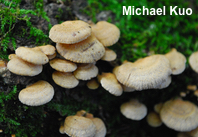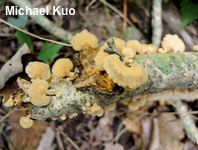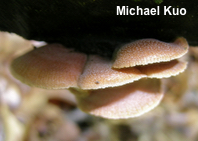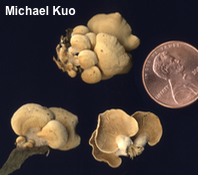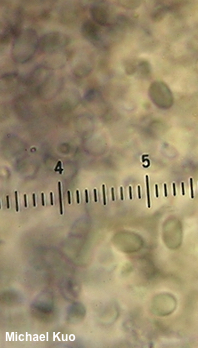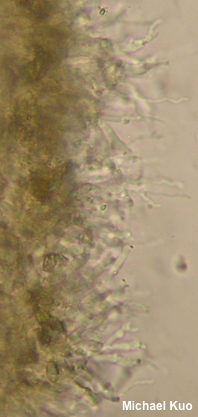| Major Groups > Gilled Mushrooms > Pale-Spored > Pleurotoid Mushrooms > Panellus stipticus |

|
[ Basidiomycota > Agaricales > Mycenaceae > Panellus ... ] Panellus stipticus by Michael Kuo, 18 March 2024 Panellus stipticus is a widely distributed, hardwood-decomposing saprobe found virtually across the globe. It can be recognized by its small size (caps under 3 cm across); the tiny, lateral stem that terminates in an abrupt line where it meets the gills; the tan to brownish, woolly cap surface; the (usually) bitter taste; and the white spore print. It is quite tough, and revives in rainwater after drying out, like many Marasmius species. This little mushroom (at least the North American version) has luminescent gills! I have not often had any luck seeing the luminescence of glow-in-the-dark mushrooms, so I had my doubts—but on a family camping trip a few years ago I saw several logs full of Panellus stipticus emitting a dull yellowish glow in the dead of night, much to my amazement. "Panellus stypticus" is an alternate spelling. Thanks to Mila Visser 't Hooft for documenting, collecting, and preserving Panellus stipticus for study; her collection is deposited in The Herbarium of Michael Kuo. Description: Ecology: Saprobic on the deadwood of hardwoods; usually growing in shelving clusters; spring through fall (also over winter in warm climates, or during winter warm spells in temperate areas); originally described from France (Bulliard 1783); widespread in Europe; also distributed in Asia, Oceania, and the Americas. The illustrated and described collections are from California, Illinois, and Kentucky. Cap: 5–22 mm across; convex with an inrolled margin, becoming planoconvex with the margin even or slightly curved under; semicircular to kidney-shaped in outline; dry; finely velvety to woolly; often becoming wrinkled and somewhat cracked-scaly in age; tan to pale yellowish brown or orangish brown, sometimes fading to off-white. Gills: Terminating abruptly at the stem; crowded; short-gills frequent; often forked; with cross-veins; pale golden tan. Stem: Up to about 3 x 2 mm; lateral or off-center; fuzzy-velvety with whitish, tan, or rusty brown fuzz. Flesh: Whitish or pale brownish; tough. Odor and Taste: Odor not distinctive; taste usually bitter, but mild in some collections. Chemical Reactions: KOH negative to gray on cap surface. Spore Print: White. Microscopic Features: Spores 2.5–4 x 1.5–2 µm; ellipsoid to suballantoid; smooth; hyaline in KOH; amyloid. Basidia 22–25 x 2–3 µm; clavate; 4-sterigmate. Cheilocystidia 25–75 x 2.5–5 µm; cylindric to filiform; irregular; often diverticulate; smooth; thin-walled; hyaline to brownish in KOH. Pleurocystidia in bundles; 40–50 x 3–4 µm; long-fusiform, with apices sometimes submucronate or slightly diverticulate. Pileipellis a densely tangled cutis with some erect elements; hyaline to yellowish in KOH; terminal elements occasionally cystidium-like or forked. Clamp connections present. REFERENCES: (J. B. F. Bulliard, 1783) P. A. Karsten, 1879. (Fries, 1821; Kauffman, 1918; Miller, 1970; Smith, Smith & Weber, 1979; Phillips, 1981; Arora, 1986; Breitenbach, J. & Kränzlin, 1991; Phillips, 1991/2005; Lincoff, 1992; Vellinga, 1995; Barron, 1999; Jin et al., 2001a; Jin et al., 2001b; Roody, 2003; McNeil, 2006; Miller & Miller, 2006; Binion et al., 2008; Boccardo et al., 2008; Buczacki et al., 2013; Kuo & Methven, 2014; Desjardin, Wood & Stevens, 2015; Siegel & Schwarz, 2016; Baroni, 2017; Gminder & Böhning, 2017; Woehrel & Light, 2017; Elliott & Stephenson, 2018; Vesterholt, 2018; Læssøe & Petersen, 2019; Sturgeon, 2019; Kibby, 2020; McKnight et al., 2021.) Herb. Kuo 10010406, 10220403, 09270505, 10021601, 01302101. Herb. EIU 004. This site contains no information about the edibility or toxicity of mushrooms. |
© MushroomExpert.Com |
|
Cite this page as: Kuo, M. (2024, March). Panellus stipticus. Retrieved from the MushroomExpert.Com Web site: http://www.mushroomexpert.com/panellus_stipticus.html |
